INSTITUT SUPERIEUR D'ANTHROPOLOGIE
INSTITUTE OF ANTHROPOLOGY
ONLINE COURSES / COURS A DISTANCE
INSCRIPTION 2012 / Session II : Avril 2012
REGISTRATION 2012 / Term II : April 2012
CHINE – 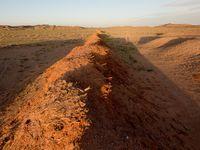 Gobi - A forgotten section of the Great Wall of China has been discovered deep in the Gobi Desert—and outside of China—researchers say. With the help of Google Earth, an international expedition documented the ancient wall for roughly 100 kilometers (62 miles) in a restricted border zone in southern Mongolia in August 2011. The defensive barrier formed part of the Great Wall system built by successive Chinese dynasties to repel Mongol invaders from the north. Preserved to a height of 9 feet (2.75 meters) in places, the desert discovery belongs to a sequence of remnant walls in Mongolia collectively known as the Wall of Genghis Khan, said expedition leader and Great Wall researcher William Lindesay. Named after the founder of the Mongol Empire, the Wall of Genghis Khan usually survives only as "a faint trace," Lindesay said in an email. But "we found a 'real wall', standing high and existing as a dominant landscape feature," he said. What's more, it wasn't the work of Genghis Khan or his heirs but actually a long-lost segment of the Great Wall of China network, the team's findings suggest.
Gobi - A forgotten section of the Great Wall of China has been discovered deep in the Gobi Desert—and outside of China—researchers say. With the help of Google Earth, an international expedition documented the ancient wall for roughly 100 kilometers (62 miles) in a restricted border zone in southern Mongolia in August 2011. The defensive barrier formed part of the Great Wall system built by successive Chinese dynasties to repel Mongol invaders from the north. Preserved to a height of 9 feet (2.75 meters) in places, the desert discovery belongs to a sequence of remnant walls in Mongolia collectively known as the Wall of Genghis Khan, said expedition leader and Great Wall researcher William Lindesay. Named after the founder of the Mongol Empire, the Wall of Genghis Khan usually survives only as "a faint trace," Lindesay said in an email. But "we found a 'real wall', standing high and existing as a dominant landscape feature," he said. What's more, it wasn't the work of Genghis Khan or his heirs but actually a long-lost segment of the Great Wall of China network, the team's findings suggest.
http://news.nationalgeographic.com/news/2012/03/120319-great-wall-of-china-mongolia-science-lindesay/
AZERBAIDJAN – 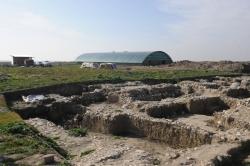 Agsu - Large-scale archaeological excavations conducted in 2010 and 2011 at the site of Agsu in Azerbaijan have revealed an extensive medieval 18th century town rich in architectural remains and artifacts, depicting a settlement with solid trade and cultural connections to other parts of the world. The uncovered remains have been organized for public viewing through a major exhibition sponsored by Azerbaijan's MIRAS Social Organization in Support of Studying Cultural Heritage. The 18th century Agsu town as revealed by the investigations represented a settlement of inhabitants who had been resettled or deported in 1735 from another city, known as Shamakhi, destroyed as a result of military conquest by Nadir Shah, who ruled as Shah of Iran (1736–47) and was the founder of the Afsharid dynasty. The city eventually developed into one of the largest cities of Azerbaijan by the end of 18th century. Although Agsu city was repeatedly exposed to feudal attacks, destruction, and inhabitant deportation during the turbulent 18th century, enough remained to show the features of a city that was circumscribed with fortified walls, a castle with round defensive towers, and other dwellings that were erected very close to each other with narrow streets, along with other comparatively wider central streets.
Agsu - Large-scale archaeological excavations conducted in 2010 and 2011 at the site of Agsu in Azerbaijan have revealed an extensive medieval 18th century town rich in architectural remains and artifacts, depicting a settlement with solid trade and cultural connections to other parts of the world. The uncovered remains have been organized for public viewing through a major exhibition sponsored by Azerbaijan's MIRAS Social Organization in Support of Studying Cultural Heritage. The 18th century Agsu town as revealed by the investigations represented a settlement of inhabitants who had been resettled or deported in 1735 from another city, known as Shamakhi, destroyed as a result of military conquest by Nadir Shah, who ruled as Shah of Iran (1736–47) and was the founder of the Afsharid dynasty. The city eventually developed into one of the largest cities of Azerbaijan by the end of 18th century. Although Agsu city was repeatedly exposed to feudal attacks, destruction, and inhabitant deportation during the turbulent 18th century, enough remained to show the features of a city that was circumscribed with fortified walls, a castle with round defensive towers, and other dwellings that were erected very close to each other with narrow streets, along with other comparatively wider central streets.
http://popular-archaeology.com/issue/march-2012/article/extensive-medieval-town-in-azerbaijan-uncovered-by-archaeologists
PAKISTAN – 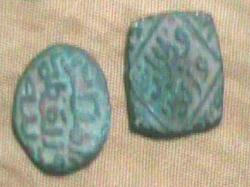
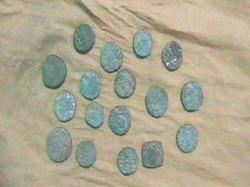 Shujabad - Bilal, a daily-wage labourer, and his two colleagues, had brought the coins along with other items in a chest they said they had found during digging at a vacant plot of land on Friday morning. The collection includes coins believed to be minted during the Tughlaq dynasty.
Shujabad - Bilal, a daily-wage labourer, and his two colleagues, had brought the coins along with other items in a chest they said they had found during digging at a vacant plot of land on Friday morning. The collection includes coins believed to be minted during the Tughlaq dynasty.
http://tribune.com.pk/story/352275/antique-find-archeology-dept-to-receive-coins-today/
FRANCE – 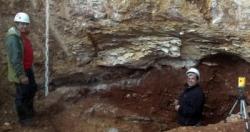 Assier - Ce n'est pas suffisamment fréquent pour ne pas le signaler. Les archéologues présents sur les fouilles ont insisté pour souligner le bon réflexe d'ERDF. Lors du creusement pour l'installation d'une cuve béton au poste source d'EDF d'Assier, les ouvriers ont mis à jour une portion de grotte colmaté par de l'argile et rempli d'ossements. L'entreprise a parfaitement joué sont rôle en prévenant immédiatement le personnel de recherche du Service Régional d'Archéologie de Midi Pyrénées afin que celui-ci procède à des expertises. « Nous avons constaté que les ossements appartenaient à des espèces très anciennes de chevaux, bisons et loups vivants en températures assez froides » ; pas d'ours pour le moment et pas encore de dates précises, mais une datation possible très haute qui donne à la découverte beaucoup d'importance. Les ossements sont très bien conservés et donneront lieu à des études poussées au niveau universitaire. M.Maskud explique qu'il s'agit probablement d'un « piège à faune », un gouffre naturel dans lequel les animaux tombaient et mouraient, créant un grand cône d'ossements divers. Malheureusement une grande partie des ossements a été brisée lors des premières excavations. Aucun signe d'activité humaine a été relevé jusqu'à présent. L'action qui rentre dans un « Plan de Sauvetage Urgent » suite à cette découverte fortuite, durera environ une semaine.
Assier - Ce n'est pas suffisamment fréquent pour ne pas le signaler. Les archéologues présents sur les fouilles ont insisté pour souligner le bon réflexe d'ERDF. Lors du creusement pour l'installation d'une cuve béton au poste source d'EDF d'Assier, les ouvriers ont mis à jour une portion de grotte colmaté par de l'argile et rempli d'ossements. L'entreprise a parfaitement joué sont rôle en prévenant immédiatement le personnel de recherche du Service Régional d'Archéologie de Midi Pyrénées afin que celui-ci procède à des expertises. « Nous avons constaté que les ossements appartenaient à des espèces très anciennes de chevaux, bisons et loups vivants en températures assez froides » ; pas d'ours pour le moment et pas encore de dates précises, mais une datation possible très haute qui donne à la découverte beaucoup d'importance. Les ossements sont très bien conservés et donneront lieu à des études poussées au niveau universitaire. M.Maskud explique qu'il s'agit probablement d'un « piège à faune », un gouffre naturel dans lequel les animaux tombaient et mouraient, créant un grand cône d'ossements divers. Malheureusement une grande partie des ossements a été brisée lors des premières excavations. Aucun signe d'activité humaine a été relevé jusqu'à présent. L'action qui rentre dans un « Plan de Sauvetage Urgent » suite à cette découverte fortuite, durera environ une semaine.
http://www.ladepeche.fr/article/2012/03/19/1309285-assier-un-piege-a-faune-ancestral-decouvert.html
USA – Kanab - A final resting place is finally coming for 53 people whose remains have been kept in a metal box for years. The first set of Native American bones was found almost five years ago by crews building the Jackson Flat Dam Water Supply Storage Facility near Kanab. Over a year’s time, a total of 54 set of bones were found. One set of bones was left undisturbed. Archaeologists say the people were originally buried about 1,000 years ago. The archaeologists uncovered 30 pit houses, and they believe many more remain hidden beneath the surface of the site. They also found about 100 smaller structures that were evidently used to store food crops such as corn, beans and squash. Families of the ancient Puebloan culture are believed to have lived on the site, more or less continuously, through many generations.
http://www.deseretnews.com/article/865552485/Remains-of-53-people-unearthed-during-construction-to-be-laid-to-rest-again-in-southern-Utah.html
TURQUIE – 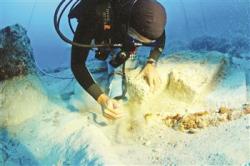 Claros - Scholars have revealed that artwork and tons of pillars and winch barrels that were discovered by underwater archaeologist and researcher Can Pulak in 1993 close to the Aegean district of Çeşme originally came from Apollon Temple in Claros. Five years of conservation work have revealed that the ship, known as the Kızılburun shipwreck, took its name from the ancient name of Marmara Island, “Prokenessos,” and sank during a storm in Kızılburun while carrying cargo to the Apollon Temple in the ancient city of Claros, according to Underwater Research Institute (INA) Director Tuba Ekmekçi. Half of the conservation of the works that were discovered have been completed, she said.
Claros - Scholars have revealed that artwork and tons of pillars and winch barrels that were discovered by underwater archaeologist and researcher Can Pulak in 1993 close to the Aegean district of Çeşme originally came from Apollon Temple in Claros. Five years of conservation work have revealed that the ship, known as the Kızılburun shipwreck, took its name from the ancient name of Marmara Island, “Prokenessos,” and sank during a storm in Kızılburun while carrying cargo to the Apollon Temple in the ancient city of Claros, according to Underwater Research Institute (INA) Director Tuba Ekmekçi. Half of the conservation of the works that were discovered have been completed, she said.
Some 16 archaeologists from the United States, Europe and Turkey brought large marble winch barrels, capitals, anchors, marble gravestone, a Hermes statue and amphoras to the Underwater Archeology Museum in the southwestern district of Bodrum. The shipwreck was discovered during a dive by Pulak and was unearthed in 2005 as a result of work carried out by the Turkish Culture and Tourism Ministry, INA and Texas A&M University.
http://www.hurriyetdailynews.com/secret-of-shipwreck-solved-after-five-year-conservation.aspx?pageID=238&nID=16352&NewsCatID=375